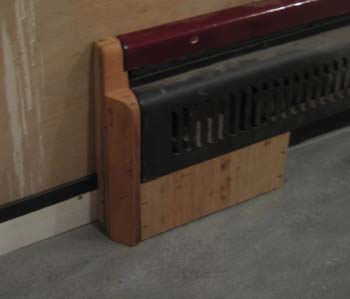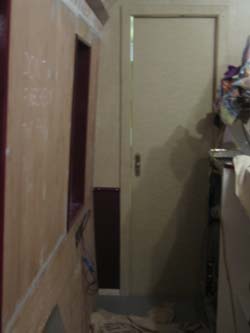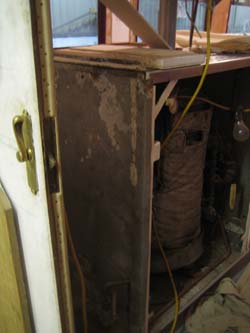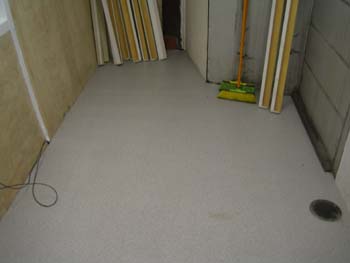
During late autumn and winter of 2007 the laying of the linoleum was
completed including non-slip material laid behind the bar and on the kitchen floor. Prior to the laying, this area of
floor also had to be hardboarded as per the saloon area. Packing the original floor so it was flat enough to take the
hardboard was quite time consuming.
The weird shaped wood pieces to finish off the ends of the steam heating
pipe cowlings were manufactured by Jim & Robin. These were cut at 45° to minimise the possibility of shins being
bashed on the metal ends of the cowlings. These pieces were also used as the support for one end of the wood which boxed
in the vertical steam pipe runs at the ends of the heaters. The other set of vertical steam feed pipes on the north side
of the coach were boxed in using rather simpler geometry.


The surrounds for the saloon and bar doors towards the west end of the vehicle were covered with leatherette after the wood
had been shaped, drilled and countersunk. The facings are heald in place using chrome csk screws which are becoming increasingly
difficult to source.
The dado rail is treated in a similar way - shaped, drilled and jointed leaving a double
leatherette thickness gap at the joints so that they are a neat and tight fit when covered. The leatherette is glued to the
wood mouldings using impact adhesive and due to the large volume of work involved in this process, Dave Simpson has been
training up other members of the painting team to help with the job.

Glyn has been doing a fantastic job of making and shaping the galvanised metal plating which surrounds the boiler
as a protection against fire. Even although the cavity in which the boiler is housed is entirely lined with "Masterboard"
heat resistant insulation board, the gas inspector still insists a further layer of metal protaction is required to surround
the (gas) boiler.


Some of the original table tops have been recycled. Removing the old formica which was glued to the top has been a
monumental task. They obviously used a better class of glue in those days as the process of trying to separate formica
from wood frequently results in formica + wood coming off! Those table tops we were unable to recover were used as templates
for new ones made from recycled material themselves. The source of the 1" thick plywood was the old reading room tables
from the National Archive of Scotland which were going to be skipped but were rescued thanks to the good offices of Jim Grady,
one of the Railtour team.
Chris has been involved in the sourcing, cutting, shaping and glueing of new maroon formica
to the tabletops which exactly match the leatherette used to line the lower half of the saloon walls.
To complete the
tables, chrome plated tubing and bushing for both ends was sourced from a wholesale shop fitter (clothes racks). This tubing
is 32mm - an almost exactly correct substitute for the original 1 1/4" tubing used by the LNER.